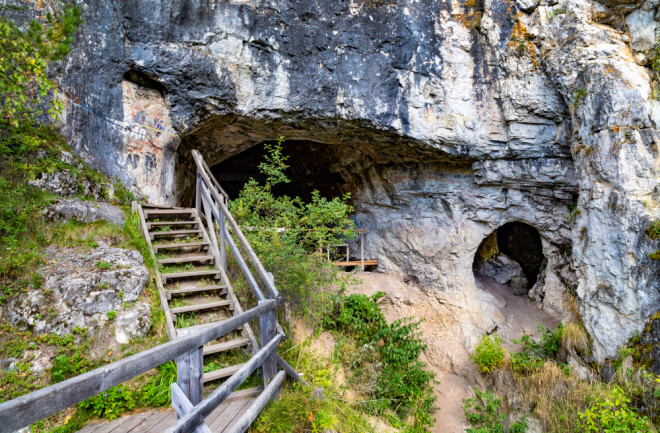Nestled in foothills of Russia’s Altai Mountains, Denisova Cave has been a research mecca since 2010, when fossil DNA from the site revealed a previously unknown human lineage, now called the Denisovans. Scientists have been working hard to reconstruct the cave’s history, through ongoing excavations as well as new analyses of materials recovered years ago.
First, what everyone wants to know: Yes, they found more human remains. Including the four Denisovan specimens (one pinky finger, two adult molars and a baby tooth), the cave has yielded 12 fossils from ancient humans, including teeth, toes, fingers and unclassifiable fragments.
Based on their genomes, proteins and physical appearance, the collection contains four Denisovans, three Neanderthals and one hybrid cross between the two human types. Excavators have also found four more fossils that belong to the Homo genus, but haven’t yet been assigned to a particular human species. Additional DNA sequences, recovered directly from the dirt, suggest the presence of even more individuals.
Sensational Scraps
Finding the fossils was a feat. Well over 100,000 bones have been excavated from Denisova Cave, but most are scraps, no longer than a matchstick, that have been chomped, crushed and eroded over the ages. It’s impossible to say what creatures they came from just by looking. So, Oxford graduate student Samantha Brown subjected thousands of the bones to protein analysis. The method, ZooMS (Zooarchaeology by Mass Spectrometry), can distinguish human collagen (the main protein in bone) from that of other animals, but cannot narrow it down to a particular human type — Neanderthal, Denisovan or modern human. Testing more than 4,500 specimens in two studies, Brown found loads of sheep, mammoth and hyena — and four humans.
Among the bones identified by ZooMS was one labeled “Denisova 11.” This corroded, inch-long splinter was justifiably described as appearing “quite unremarkable” in the original report. But subsequent genomic analysis in 2018 revealed that Den 11 — now more affectionately known as Denny — was the lovechild of a Neanderthal mother and Denisovan father.
We’ve known for years that different types of humans interbred. But this was based on short stretches of cross-species DNA detected in people living many millennia after the mating occurred. Denny, on the other hand, is the direct result of Neanderthal-Denisovan sex roughly 90,000 years ago. She is the first human hybrid to be discovered.
Missing sapiens
We also have a better grasp on the timing of human habitations and environmental changes at Denisova Cave, thanks to a pair of Nature papers published earlier this year. Using a variety of dating methods, one paper showed Denisovans likely resided there roughly 106,000 to 194,000 years ago and again 52,000 to 84,000 years back. Neanderthals, including Denny the hybrid, seem to have been sandwiched in the time between. The other study tracked animal and plant species, using bones and pollen, respectively, through the cave layers to reconstruct past ecological conditions. The researchers concluded that between 20,000 and 300,000 years ago, the region fluctuated numerous times from a cold, shrubby tundra to a temperate forest of pine and birch.
Neither study — nor any other research to date — has proven that Stone Age Homo sapiens inhabited Denisova Cave, though distinctive bone points and beads found there seemed to hint at their presence. Researchers had thought these were made exclusively by H. sapiens, but now, with no modern human fossils yet unearthed, some researchers are rethinking this assumption. It’s possible Denisovans or Neanderthals actually crafted the relatively sophisticated items.
Beyond Denisova Cave
But the biggest Denisovan news of late comes from far beyond the eponymous cave — approximately 1,200 miles away in Xiahe county, China, on the northern edge of the Tibetan Plateau. In 1980 a Buddhist monk, meditating in a cave two miles above sea level, came across an unusual jawbone with giant teeth. The fossil ended up at the nearby Lanzhou University, where it sat for nearly four decades, until archaeologist Dongju Zhang and geologist Fahu Chen took interest.
The researchers analyzed proteins in the jawbone and dated the fossil’s calcite crust, and found that it belonged to a Denisovan who lived about 160,000 years ago. Not only is it the first Denisovan found outside Denisova Cave, it’s also the largest specimen of their kind: the right half of a lower jaw. They published their findings in May.
Scientists already suspected Denisovans were adapted to high elevation. Modern Tibetans carry a Denisovan gene, inherited from ancient interbreeding, that allows them to live miles high today. But this altitude-gene was puzzling because Denisova Cave itself is not particularly high. Its entrance, about 2,200 feet above sea level, is similar in elevation to Minnesota’s highest spot.
Meanwhile, the Xiahe jawbone comes from a cave at 10,760 feet, well above the point where the human body begins to struggle due to the low oxygen. Finding this Denisovan on the Tibetan Plateau confirms our cousins were indeed highlanders.
The discovery also suggests other Denisovans are likely out there, hiding in plain site: fossils found and forgotten years ago, awaiting another look.

